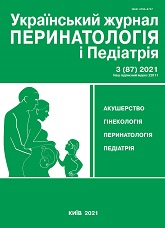Risk assessment of intrauterine infection in pregnant women with chronic hepatitis B
DOI:
https://doi.org/10.15574/PP.2021.87.12Keywords:
pregnant women, chronic hepatitis B, co-HIV infection, risk factors for intrauterine infection of the fetusAbstract
Purpose — to develop a method for predicting intrauterine fetal infection in pregnant women with CHB, infected and uninfected HIV, which provides the high accuracy of prognosis, is simple and accessible in practice and is achieved by analyzing multiple risk factors for mother-to-fetus transmission.
Materials and methods. The course and consequences of pregnancy were analyzed in 211 women with chronic hepatitis B (CHB), not infected with HIV and in 18 — with CHB infected with HIV. The replicative activity of the virus and the activity of the inflammatory process in the liver were evaluated. We studied the dynamics of indicators depending on the trimester of pregnancy, the degree of immunosuppression caused by HIV. The frequency of risk factors was determined by «case-control» studies, and the frequency of identified risk factors was calculated in the groups of mothers in whom CHB was transmitted to the child and in those in which it did not occur. The degree of influence of individual risk factors was determined by the value of relative risk (RR), determined by their 95% confidence interval (95% CI), the reliability of the results (p) according to the Student's t-test. Differences at p<0.05 were considered probable.
Results. It is established that risk factors that contribute to intrauterine infection of the fetus are: maternal — viral load HBV >105 copies/ml in the third trimester, HIV infection, immunosuppression caused by HIV (CD4+ Т-lymphocytes <500 cells/μL), low adherence to antiretroviral therapy, maternal bad habits; fetal — intrauterine growth restriction, fetal distress; obstetric — premature placental abruption, preterm delivery, placental dysfunction, prolonged anhydrous interval, prelabor rupture of membranes.
In pregnant women with CHB, each risk factor was assessed in points depending on the RR: those factors whose relative risk was highest — 5 points, those whose score was lower — 4 and 3 points, respectively, and those whose score was the lowest — in 2 points.
In order to predict the risk of fetal infection, a working prognostic chart with a score from 2 to 5 was developed. It was found that the risk of HBV infection in women with HIV-negative status is high with a score of 19–34, moderate — at 18–11, low — <10 points. In women with HIV-positive status — high risk of fetal intrauterine infection at a score of 24–46, moderate — at 13–23, low — <12 points.
Conclusions. The use of the proposed prognostic map in the practice of medical institutions with a score of total risk factors for each pregnant woman will facilitate early prediction of fetal infection in pregnant women with CHB, taking into account their HIV status, which will allow to diagnose timely congenital infections and provides outpatient observation for these children.
The research was carried out in accordance with the principles of the Helsinki declaration. The study protocol was approved by the Local ethics committee of all participating institution. The informed consent of the patient was obtained for conducting the studies.
No conflict of interest was declared by the authors.
References
Avdeeva MG, Gorodin VN, Kulbuzheva MG (2015). Chronic viral mixed hepatitis: modern clinical and epidemiological aspects. Epidemiology and infectious diseases. 6: 19–25. https://doi.org/10.17816/EID40876
Domashenko ON, Cherkasova TI, Skorik SB. (2017). Hepatitis in pregnant women. Medico-social problems of the family. 22 (1): 44–47.
Golubovska OA, Vysotska OI, Bezrodna OV. (2017). The role of primary care for patients with hemocontact infections (HIV and hepatitis B and C). Infectious diseases. 1 (87): 5–8.
MOZ Ucrainy. (2018). Hepatitis B in Ukraine: epidemiological characteristics and assessment of severity (based on data from various sources). Public Health Center of the Ministry of Health of Ukraine. URL: https://phc.org.ua/sites/default/files/u&ploads/files/VGV&2018.pdf.
Pereverten LYu, Matyushkina LS, Rachkova EV (2014). Clinical and laboratory characteristics of chronic viral hepatitis in pregnant women. Modern science-intensive technologies. 12: 66–70.
Sagnelli E, Alessio L, Sagnelli C et al. (2017). Hepatitis B virus genotypes, epidemiological characteristics and clinical presentation of HBV chronic infection in immigrant populations living in southern Italy. Hepat Mon. 17: 32-60. https://doi.org/10.5812/hepatmon.13740
Shadrin OG, Chernega NF, Dyukareva SV et al. (2014). Clinical and paraclinical features of hepatitis B and C in young children with perinatal infection. Neonatology, surgery and perinatal medicine. 44 2 (12): 96-100. https://doi.org/10.24061/2413-4260.IV.2.12.2014.12
Terrault NA, Bzowej NH, Chang KM, Hwang JP et al. (2016). AASLD guidelines for treatment of chronic hepatitis B. Hepatology. 63 (1): 261-283. https://doi.org/10.1002/hep.28156; PMid:26566064 PMCid:PMC5987259
World Health Organization. (2017, July). Hepatitis B vaccines: WHO position paper. Wkly Epidemiol Rec. 92: 369-392.
Zaitsev IA. (2017). Viral hepatitis in women of reproductive age. Topical infectology. 5; 3: 123-128. https://doi.org/10.22141/2312-413x.5.3.2017.109854
Downloads
Published
Issue
Section
License
The policy of the Journal “Ukrainian Journal of Perinatology and Pediatrics” is compatible with the vast majority of funders' of open access and self-archiving policies. The journal provides immediate open access route being convinced that everyone – not only scientists - can benefit from research results, and publishes articles exclusively under open access distribution, with a Creative Commons Attribution-Noncommercial 4.0 international license(СС BY-NC).
Authors transfer the copyright to the Journal “MODERN PEDIATRICS. UKRAINE” when the manuscript is accepted for publication. Authors declare that this manuscript has not been published nor is under simultaneous consideration for publication elsewhere. After publication, the articles become freely available on-line to the public.
Readers have the right to use, distribute, and reproduce articles in any medium, provided the articles and the journal are properly cited.
The use of published materials for commercial purposes is strongly prohibited.

